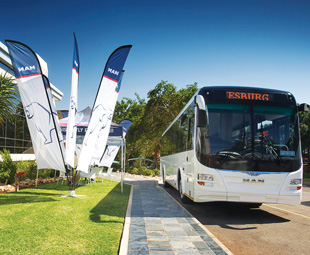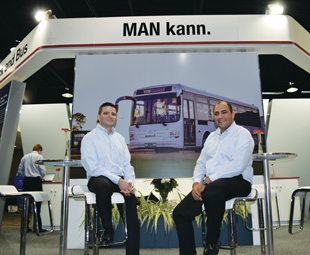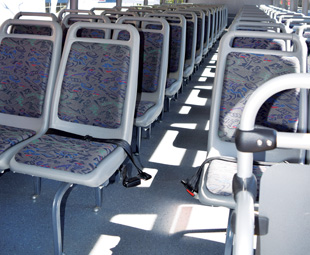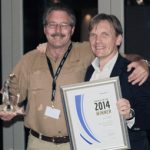An exciting vehicle for a maturing market

MAN Truck & Bus South Africa made its return to the annual Southern African Bus Operators Association (Saboa) conference showing its exciting new product. GAVIN MYERS brings you the details.
The Saboa conference this year saw an exciting number of luxury coaches on display. “It’s like looking at the fancy cars at a car show; the coaches are flashy and people like to look at them,” says Philip Kalil-Zackey, head of bus sales at MAN Truck & Bus South Africa.
Of course, there were also commuter and city buses that delegates are more accustomed to seeing at the conference. This year, MAN showed off perhaps one of the most intriguing vehicles that made its debut at the conference – the company’s RR9: a high-floor, rear-engined city bus with a MAN Lions City R body.
 “MAN is a key supplier to the passenger transport industry,” says Geoff du Plessis, MD of MAN Truck & Bus SA, adding that the RR9 complements traditional city buses by being “a nice in-between vehicle that can be used in commuter and city applications”.
“MAN is a key supplier to the passenger transport industry,” says Geoff du Plessis, MD of MAN Truck & Bus SA, adding that the RR9 complements traditional city buses by being “a nice in-between vehicle that can be used in commuter and city applications”.
It can be used in bus rapid transit (BRT) as well, adds Tiago Dias, head of department: national accounts responsible for buses at MAN Truck & Bus South Africa, as it is configurable with doors on the right-hand side.
“This is made possible by the fact that the RR9 chassis is modular; made of front, centre and rear modules, so one can configure it how one likes with different axles, engines, overhangs, and so on,” Dias continues. However, while this certainly gives bodybuilders more flexibility, at the moment the local offering consists of one configuration with 65 seats.
“We’ve optimised it for South African conditions,” notes Kalil-Zackey, “to give the market exactly what it wants.”
This includes air suspension for good ride comfort and all the safety bells and whistles, which include Anti-lock Braking (ABS) with Electronic Brake System (EBS), Traction Control, a kneeling function, a two-piece curved windscreen, two emergency-exit roof hatches, and LED lights.
 The body (which is built at MAN’s bus plant in Olifantsfontein, and the chassis assembled at its Pinetown facility) complies with the required 80 percent local-content legislation.
The body (which is built at MAN’s bus plant in Olifantsfontein, and the chassis assembled at its Pinetown facility) complies with the required 80 percent local-content legislation.
The vehicle is powered by a 184 kW (250 hp) Euro-5 six-cylinder engine. “It’s part of the D08 family. We know the technology well,” says Kalil-Zackey. He is keen to point out that the Euro-5 standard is met without the need for AdBlue, by employing the use of an oxidation catalytic converter and double-stage turbocharging.
One of MAN’s key customers has been running the RR9 for six months, and the company is happy with the positive feedback it has received from the customer, its passengers and its drivers. “There has also been a lot of interest in the bus at Saboa; a few of our big customers, as well as some of the cities, are very interested in the unit,” says Kalil-Zackey.
“It fits nicely into the MAN family line, because we now have front engine high-floor, rear engine high-floor and rear engine low-entry buses,” adds Dias. “We have something to offer the whole spectrum of market requirements at the moment.”
Kalil-Zackey also notes that the local market is maturing: “New products and operations will come to the fore. The old traditional ways will change … BRT and the city operations are moving there already. If you really want to get people out of cars, you have to make it convenient and give them an incentive – safety, air-conditioning, something modern and accessible.
 “We can’t stop one type of operation and implement another. There is a place for all types of operations in our market. BRT is BRT, the city buses must still function to feed them. They need to be pulled together and integrated to work in tandem. Tshwane is interesting, because it has just implemented BRT as well as new city buses and the two systems are working together, not against each other.”
“We can’t stop one type of operation and implement another. There is a place for all types of operations in our market. BRT is BRT, the city buses must still function to feed them. They need to be pulled together and integrated to work in tandem. Tshwane is interesting, because it has just implemented BRT as well as new city buses and the two systems are working together, not against each other.”
Dias adds: “It’s how you cover the gaps that determines whether people will use the system or not. While the majority of the population has to use public transport, to get motorists out of their cars will be tough. They won’t walk kilometres to a bus stop … In Europe you don’t need to walk more than 500 m from anywhere to a bus stop. We also have to implement through-ticketing. Once we have that there will be a very good system.”
Of course, these are just the sort of topics debated at the Saboa conference. Du Plessis, Kalil-Zackey and Dias are equally impressed with the platform for networking and interaction that the conference provides. It allows the staff of MAN the opportunity to touch base with many of their component suppliers, who are also present, and see what’s new on the market.
“It’s nice to have everybody around. The staff get a chance to see what’s happening and have an opportunity to interact. It’s important that they get to see what our competitors are offering and get feedback from customers. It’s not often they get to meet the end user,” they note.
Of course, judging by the enthusiasm surrounding the new RR9, MAN will undoubtedly have had many a happy delegate leaving the Saboa 2015 conference.
Published by
Focus on Transport
focusmagsa




